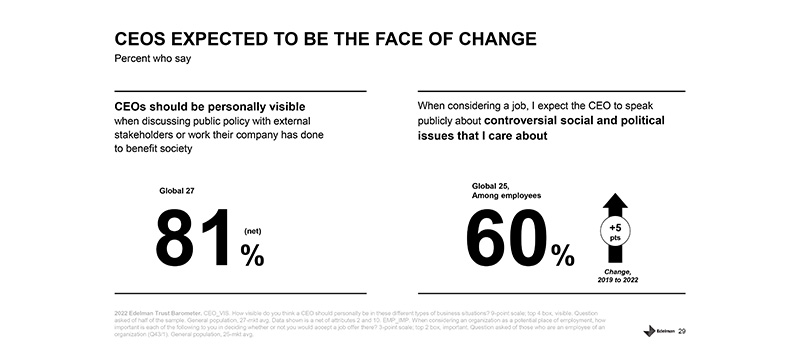Building trust is vital to any branding strategy.
For all our complexities, we humans are pretty simple…
We’ve survived for millions of years because we’ve learned to cooperate in tribes and social circles and the core of this is trust.
It’s part of our psychology to choose who we interact with based on trust levels.
We choose to talk to, confide in, and share our time with people we trust. We avoid people we believe to be inauthentic or untrustworthy.
We apply the same process to our buying behavior.
Consumers prefer to interact with brands they trust, making brand trust a hugely important differentiator in the market.
When it comes down to the critical purchasing moment, consumers trust is a fundamental decision-making factor that few brands have the luxury of bypassing.
Therefore, building consumer trust and subsequently, a reputation of trustworthiness, enhances brand equity, market share and ultimately revenue and profits.
Before I dive into how to build brand trust, let’s define the concept a little better.
What Is Brand Trust?

Brand trust is a measure of the extent customers believe a brand will deliver on its brand promises.
If a brand consistently meets the target audience’s expectations, trust in the brand grows.
Increasingly, we expect modern brands to be true to themselves, meaning that brand values clearly influence all brand behavior.
If a brand presents a consistent customer experience that supports its brand values, the audience perceives the brand to be authentic.
Therefore, brand authenticity is an important factor within brand trust.
Again, it’s helpful to humanize brands to understand the concept of brand trust.
Just like with humans, we trust brands that seem to know what they’re doing, do what they say they will, and don’t lie to us or let us down.

Brands that seem incompetent and break promises, damage the relationship they have with consumers.
This isn’t rocket science. We all know what builds and breaks trust with the people around us. It’s no different with brands.
Elements of the brand experience that affect trust include:
Customer satisfaction with the brand’s product or service
The perception that a product or service is ‘worth it’
Social proof and testimonials
Quality and speed of customer service
Consistency of the customer experience through all touchpoints
Protection of personal data
Advocacy, or how the brand comments on social issues
It would be an oversimplification to say that if a brand performs consistently well to audience expectations, then brand trust will increase.
However, that oversimplification would serve as a decent one-sentence summary as a starting point.
Why Does Brand Trust Matter?

Having high brand trust can convince potential buyers that your brand is the best option amongst many.
In the modern marketplace, brand trust matters more than ever in its influence on buyers.
That’s because of several factors coming together to elevate the importance of trust.
PRO Brand Strategy BluePrint
Build Brands Like A Pro Brand Strategist

#1. Competitive Marketplaces

With so many brands out there, it’s difficult to retain customer loyalty.
Customers who encounter a brand experience that doesn’t live up to their expectations can simply choose an alternative provider in a competitive market.
If a brand behaves in a way that conflicts with their perceived brand image, it will lose brand equity with its audience.
This is particularly true with Gen Zers who are more perceptive of mixed brand messaging.
If a brand disappoints them, consumers will simply head elsewhere.

However, the flip side of this is that building brand trust gives brands some leeway.
Loyal customers are more forgiving to brands they trust.
If they have a bad or disappointing encounter with a trusted brand, loyal customers see it as an exception to the rule.
They’re more willing to give the brand another chance to rebuild its reputation.
But make no mistake…
Fool me once, shame on you. Fool me twice…. The point is you’re not gonna fool them again.
Brand trust is difficult to earn, but the brand loyalty you get in return means a one-off mistake may not be so damaging to your brand.
#2. Word-Of-Mouth Marketing

Consumers today expect a frictionless customer experience that goes above and beyond what used to suffice.
And, with social media as a vehicle for word-of-mouth marketing, brands get punished with terrible reviews if their customer service is not up to scratch.
Consumer buying habits have changed.
With social media, customers will look for social proof and testimonials to gauge whether to trust a brand and its products.
They are research-minded.
If it satisfies others, that convinces consumers to make a purchase.
While negative reviews can damage trust levels, positive reviews on review sites can work to entice potential customers by building a picture of a trusted brand.
That’s why brands should see developing a trusting customer relationship as a key element of their marketing strategy.
#3. A Culture of Distrust

According to the 2022 Edelman Trust Barometer, consumer trust is at an all-time low.
The report says distrust is now society’s default position.
Their market research points to the damaging effect of the pandemic, with distrust of the government and the media at unprecedented levels.
From a branding perspective, what’s important to realize is that consumers now look to businesses for leadership.

The report states that consumers are increasingly drawn to companies that take a stand. They choose to purchase from businesses that align with their political or social beliefs.
However, consumers need to trust that brands actually walk the walk with their brand values.
Building brand trust by embedding brand values into everything you do, whether it’s business actions, products and services, or marketing campaigns, will help show that you’re a company with beliefs you’re willing to advocate for.
This stance will resonate with your target audience if they share the same values.
Explore Brand Strategy
Programs & Tools
The Benefits For Trusted Brands

Building a trusting relationship with customers leads to brand loyalty.
If you show up with the same excellent brand experience through all channels, you show to the customer that you are dependable.
Customers know what they’re getting every time.
If that experience resonates with the audience, you build the emotional connection on which brand loyalty is based.
And, brand loyalty is valuable for brands for several reasons:

Loyal customers:
Will buy a brand’s product even if it isn’t the cheapest
Often exclusively buy from a brand instead of competitors
Are interested in new products from the brand
Spread your message for you, increasing brand awareness
Are happy to engage with your marketing campaigns
Will defend the brand’s reputation against criticism (to a point)
Shaping the perception of your brand as trustworthy in the audience’s mind sets you up for success.
If a consumer sees you as a trusted brand, you gain engagement, loyalty, and advocacy.
Most important of all, brand trust means you’re in with a shout when it comes to the purchase decision.
Since brand trust is so important, you’re probably wondering how you can go about building it.
Let’s run through some guidelines for building brand trust.
How to Build Brand Trust

Trust takes years to build, seconds to break, and forever to repair.
The common saying applies to trust in human relationships but is also apt for brand trust.
Brand strategists should know brand trust doesn’t materialize overnight but results from a well-thought-out long-term brand strategy.
Let’s dive in.
#1. Benchmark And Monitor Brand Trust

All branding and marketing relies on setting goals and measuring their success.
Part of building brand trust will involve brand reputation management, to set targets for brand reputation and monitor discussions online.
It’s difficult to quantify brand trust, but brand managers can perform sentiment analysis to understand how the target audience feels about the brand.
Sentiment analysis involves gathering information across many online sources to build a picture of trust levels. You can support this with consumer surveys to gather insights from respondents that can inform further brand behavior.
Also, customers will feel more valued when you take the time to hear what they have to say and act upon their recommendations.
Listening and making meaningful changes to your brand experience is a powerful way to build trust.
#2. Be Consistent

Brand consistency is critical in building trust among your customers.
Show up with a singular brand voice across all touchpoints. Once of our recent videos details 21 touchpoints to align for a consistent brand experience.
Advertisements
Social posts
Videos
Website
Podcast
Environment
Point of Sale
Packaging
Vehicle Wraps
Direct Mail
Lead magnets
Emails
Blog posts
Business Cards
Invoices
Proposals
Discoveries
Consultations
Onboarding documents
Workshops
After Sales Service
Customer support
Consistency across all channels makes your brand recognizable wherever the consumer encounters it.

Think of an Apple Store.
You could visit an Apple store in New York, London, Tokyo or Sydney and expect to see the same furniture, customer service, logo, fonts, displays, products, and overall experience.
Customers trust in the familiarity.
Customer interactions that conflict with the usual brand experience serve as harmful contradictions. An unexpected, unfamiliar experience damages that trust.
Modern consumers are more attuned than ever to conflicting messages.
Defend against mixed messaging by creating comprehensive brand guidelines to ensure alignment to present the same version of the brand through all 21 potential touchpoints.
Tone of voice guidelines can dictate verbal elements while brand identity guidelines determine visual elements.
#3. Be Authentic

For the audience to trust that you stand up for your beliefs as a brand, they must first have a clear picture of what you believe.
Create a compelling narrative around your brand that your audience will respond to, a process otherwise known as brand storytelling.
#4. Focus On Relationship Not Revenue

Don’t underestimate the power of shifting your mindset from revenue to relationships.
Developing and maintaining great customer relationships, should be your number one priority, not profits.
Successful brands understand that loyal customers are their greatest asset because of the value they can bring to the business.
PwC recently found that trust is the number one differentiator affecting a customer’s purchasing decision.
They won’t buy from a company they don’t trust
They believe it’s a company’s responsibility to build trust
In a head-to-head between two competitors, they’ll choose the company they trust
What does this mean for brands?
It means that building trusting relationships with consumers must be the primary focus over making a sale.
Why? Because the ultimate outcome is that by building trust, the sales will take care of themselves.
#5. Be Transparent

It’s not rocket science that consumers don’t like being lied to.
However, being transparent and honest as a brand is more than just abstaining from lies.
To build trust based on authenticity, you need to be proactive and upfront in your branding.
That means apologizing when things go wrong, being open about your business processes and removing any ambiguity or grey areas which could be seen as misleading.
Companies like Buffer, the social media management tool, make transparency a core value. They have a
This transparency resonates with consumers.
Brands that will apologize for mistakes and lift the veil on business practices seem more trustworthy to consumers.
Attaching a face to a brand also helps consumers relate to the company.
#6. Create Valuable Content

Much of modern branding relates to establishing yourself as an industry authority through a robust content marketing strategy.
Modern brands need to frame themselves as solution providers.
Customers have pain points that need to be solved.
You can solve their problems through products or services, but you should support this by offering helpful content.
Create webinars, monthly newsletters, video tutorials, blog posts, or downloadable ebooks.
Whatever works in your brand’s context in a format that suits your audience.
If your brand offers helpful, authoritative content, your brand builds a reputation as a knowledgeable source that consumers can trust.
Becoming that go-to source for helpful content takes time and effort and requires a comprehensive content marketing strategy that addresses the issues your audience faces.
#7. Build Social Proof

Both trust and distrust are contagious.
I already mentioned the pivotal role that social proof plays in building trust.
Consumers sit up and take notice of what other people think of your products, services, and general brand experience.
Another
Positive reviews represent a potentially powerful asset for you to leverage.
Successful brands attempt to collect positive social proof and make it more visible to others.
They’ll share testimonials on their website and user-generated content on social media.
Nothing quite sells your brand like evidence of customers enjoying your product, service, or brand experience.
Sharing social proof can cause a positive reinforcement loop as evidence of trust breeds more trust.
Over To You
It should be clear that maintaining brand trust is a never-ending task.
Reliability, consistency, transparency, and authenticity are guiding principles you should never sway from in your branding efforts.
Hard work can be undone quickly in the audience’s mind and brand reputations can face irrevocable damage overnight.
However, fortunately, building a trusted brand through an aligned brand experience pays dividends.
Consumers who trust brands become loyal.
They choose your brand over competitors.
They advocate for your brand.
They engage with your brand’s communications.
If it was easy, every brand would do it. It’s not easy.
It’s challenging and requires hard work and dedication.
But like everything, the best rewards are there for the few who prevail.
On-Demand Digital Program
Brand Master Secrets
Make the transition from hired-gun to highly valued brand strategist in less than 30 days. The systems, frameworks and tools inside this comprehensive program are all you need to level up.








